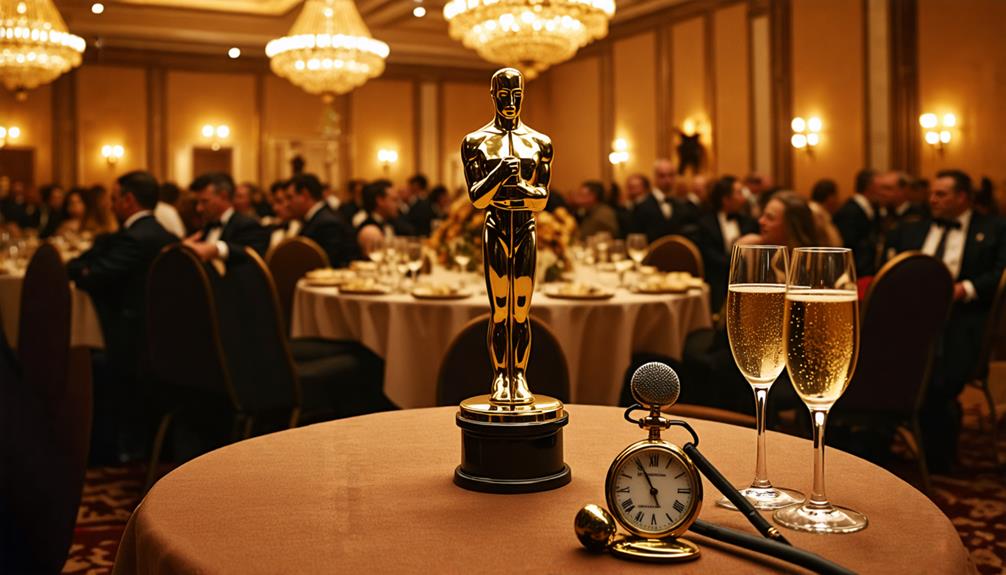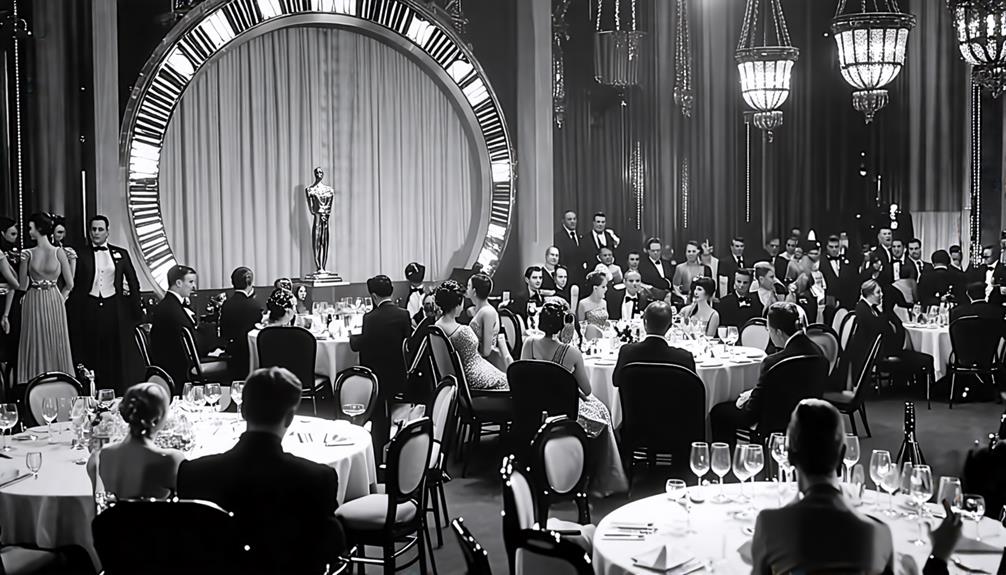You might be surprised to learn that the first Oscars ceremony was a far cry from the glitzy, hours-long extravaganza that is familiar to us today. In fact, it lasted a mere 15 minutes. This brief affair, held in 1929, set the stage for what would become Hollywood's most prestigious event. But what led to such a short ceremony, and how did it transform into the elaborate production we now anticipate each year? The answer lies in the evolution of the film industry itself and the growing importance of cinematic recognition.
Key Takeaways
- The inaugural Academy Awards ceremony in 1929 lasted only 15 minutes, contrasting sharply with modern lengthy productions.
- Held at the Hollywood Roosevelt Hotel, the event was a small, intimate gathering of 270 guests.
- The brief duration reflected the simplicity of early Hollywood events compared to today's elaborate ceremonies.
- Winners were announced three months in advance, eliminating suspense and contributing to the ceremony's brevity.
A Brief Inaugural Event

Hollywood's first Academy Awards ceremony was a far cry from today's glitzy extravaganza, lasting a mere 15 minutes and lacking the suspense we've come to expect. The event took place on May 16, 1929, in the Blossom Room of the Hollywood Roosevelt Hotel.
Unlike the hours-long productions you're used to now, this inaugural ceremony was remarkably brief. With winners announced three months in advance, there was minimal audience engagement during the event itself.
The first Oscars honored films from 1927 to 1928, presenting awards across 12 categories. 'Wings' took home the coveted Best Picture award.
If you'd been there, you would've paid $5 for a ticket (about $87 today) and joined around 270 guests. It's hard to imagine such a short ceremony compared to the lengthy spectacles you see today.
Silent Films Take Center Stage
At the inaugural Oscars ceremony, you'd have witnessed the pinnacle of silent film's golden age, with these masterpieces dominating the awards landscape. The first Oscars recognized the dominance of silent films in early Hollywood, with 'Wings' taking home Best Picture. You'd have seen Emil Jannings and Janet Gaynor honored for their performances in silent films, showcasing the era's top talent.
The ceremony highlighted silent cinema's importance through:
- 12 categories primarily featuring silent films
- Only one sound film, 'The Jazz Singer,' among nominees
- Recognition of multiple silent film performances for acting awards
You'd have observed the shift period in Hollywood, as the ceremony honored films from 1927 to 1928. This event captured a unique moment in cinema history, celebrating silent films' artistry just as the industry was on the cusp of change.
Evolution of Hollywood's Biggest Night

From the silent film era's final hurrah, you'd be amazed to see how the Oscars have transformed over the years, starting with a brief 15-minute ceremony that's now evolved into Hollywood's biggest night.
The first Oscars ceremony in 1929 was an intimate affair at the Hollywood Roosevelt Hotel, with just 270 guests and 12 categories. You'd barely have time to settle in before it was over!
Fast forward to today, and you'll find a grand event with 3,400 attendees and 24 categories. This evolution reflects the growing significance of the film industry's most prestigious awards.
The ceremony's broadcast debut in 1953 marked a turning point, reaching 20 million viewers. Now, you can witness the glitz and glamour from your living room as Hollywood's finest vie for the coveted Best Picture award, a far cry from the days when silent films like 'Wings' took center stage.
Conclusion
You've glimpsed the humble origins of Hollywood's most prestigious event.
From a 15-minute gathering to today's extravaganza, the Oscars have come a long way.
As you reflect on this transformation, remember that even the grandest traditions start small.
The next time you're watching the hours-long ceremony, you'll appreciate how it's grown from those modest beginnings, celebrating cinema's evolution and the enduring magic of the silver screen.

Leave a Reply